Many students at Carlson today believe in the power of business to improve lives and to make a positive impact. I know, because I’ve met, discussed, debated and explored this issue with many of them-- because they’re my classmates. In fact, it’s this belief that motivated me to enroll into the Carlson School of Management last year. Before business school, I worked in journalism and international development, and throughout all of my life, the arts have run parallel and supported these experiences. Because art is so deeply entrenched in empathy, art has been a way for me to process and understand-- it’s a framework. As a current second year, full time MBA student, I have spent the last year learning the "tools of the trade" in business, like accounting, finance, marketing, and strategy. These tools are the concepts and new frameworks, which when applied appropriately, have the power to improve countless lives in society. As my professor, Toby Nord likes to say, "Business is about solving real problems for real people." This is where the arts and business are similar---both disciplines need innovative thinkers who can create a world no one else has seen.
Business school has taught me to see the world differently, through a new lens and perspective. In creating this painting, I wanted to share what I’ve learned and wanted to help bring to life the ideas I’ve encountered, and to answer the following questions:
My creative process falls, roughly, into four categories:
Today I drove out of the city from Minnesota to Wisconsin to visit my friend Zoe, a fellow Returned Peace Corps Volunteer. During the drive, I began my "concepting." At the start of any creative project, I find the first step is usually trying to listen to the ideas swirling around in my head and identifying what I need to find out. The assignment is this-- How do I create a painting that represents "Business As a Force for Good?"
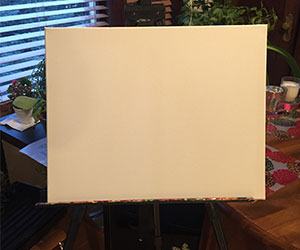
When I think about what "business" means, one thing I know to be true is that we must remember that it’s all around us. Whether we think about it or not, we are all a part of this "marketplace" where we buy products and services that we believe will add the most value to our lives. For example, last time I visited Zoe, she remarked about her two pet ferrets, Koki and Fox.
"They are expensive, and to honest, can be a lot of time and energy to take care of—but you know what? They bring so much joy to my life." It might seem silly to draw deep insights from musings on owning pet ferrets, but I find this sort of profound! Because I think that’s important to remember-- People spend according to their values, and what we have to spend goes beyond money. It’s about time and energy as well, and spending those things to bring us joy.
At its essence… business is an exchange of value.
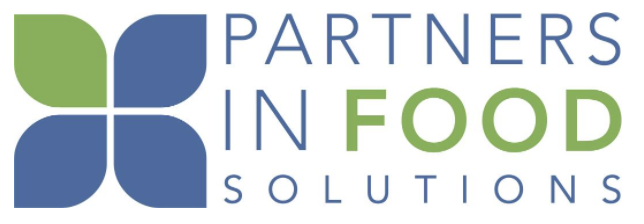
Partners in Food Solutions (PFS), where I’m interning this summer, has a great origin story. It’s also a great example of "Business for good." The CEO of General Mills was asked by Kofi Annan, Former UN Secretary General, "What are you doing to address food security in Africa?" And the answer to this question, months later, was the creation of PFS. Today, the PFS mission is to "strengthen food security, improve nutrition and increase economic development" across Africa. Spending the summer here has allowed me to expand on work I did as a Peace Corps Volunteer. One of my key takeaways from Peace Corps was an appreciation of the role of business and industry within international development. To achieve significant progress, developing nations need economic opportunities, infrastructure, and employment, and this is where private industry can play a significant role in advancing development. Food scientists and business professionals who volunteer for Partners in Food Solutions are supporting small to mid-sized food processors in Africa, in order to capture more of the food processing value in Africa—this will create more jobs and build a more robust ecosystem for development.
When I asked Jeff Dykstra, the CEO of PFS, "What does business for good mean to you?" he discussed the importance of companies around the world thinking about the long-view, and about how business leaders today are figuring out new, innovative ways to grow their business while simultaneously benefiting the communities in which they operate.
I read an article today called Shared Value, by Michael Porter, from 2011. The key idea of "Shared Value" is that businesses are able to generate economic value in a way that "also produces value for society by addressing its challenges. A shared value approach reconnects company success with social progress."
This can be accomplished in three ways:
Businesses can also give philanthropically, but that’s not the same thing as embodying a "shared value" approach. With shared value, the collaboration of efforts and creation of value expands into new opportunities for stakeholders—by doing good, Porter argues, a company can actually perform better.
Today I grabbed coffee with Bill Sands. Bill and I first connected over a mutual love of the arts, and through a program he and his wife, Susan, support at Carlson called the "Sands Fellowship," which has assisted socially-minded business students launch over a dozen for-profit ventures ranging from "workforce training for disadvantaged groups, affordable housing, medical devices," etc. Through this program, Bill and Susan Sands have been fast supporters of students coming to business school wanting to make an impact. They wanted to let students know that you can be financially successful by committing yourself to your community.
Over coffee, Bill told me, "I’m sure you’ve heard this, but I’ll say it again, you can do well by doing good—whether that’s in your business or your personal life."
When I asked him about what his hope is for future business leaders, he said "So many people get wrapped up in their cocoons. I hope more students think about leaving the world better than they found it."
My colleague, Ginger, a Carlson grad with a background in supply chain said to me today, "Business has surprised me in that everything comes down to people. Sometimes we forget that." Take suppliers for example, how do you choose which supplier to go with? "You want to be fair, but also, you want to like who you work with and know that you are doing business with good people." I keep hearing this theme of good people and building relationships, and about thinking beyond individual roles and responsibilities about how your work affects your local and global community.
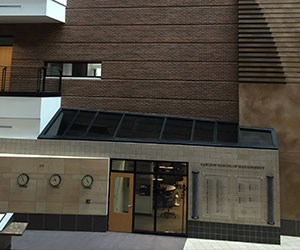
Today I placed the order for my canvas! We decided that spot in the atrium which would make most sense is the empty area just above the funds enterprise classroom-- and that gives me a space of about 15 ft. by 18 ft! They don’t make canvases this large normally. After searching around art supply stores, I realized that the easiest place to get a canvas would be finding a large, 15 by 18 ft canvas drop cloth, like the ones painters use to cover furniture before they paint your house. I can paint that, and it should function just fine as a canvas. Fingers crossed!
I Google image searched "Business" today to see what came up, and found stock image photos of "business". I think of an excerpt from Phil Knight, the founder of Nike’s book, "Shoe Dog," where he explains all of the crazy people and decisions he met along the way to build NIke, and that the term "business" is so much more than it’s often described and represented (like it is in these stock photos) he says, "What we were doing felt like so much more. Each new day bought fifty new problems, fifty tough decisions that needed to be made, right now, and we were always acutely aware that one rash move, one wrong decision could be the end. The margin for error was forever getting narrower, while the stakes were forever creeping higher…We wanted, as all great businesses do, to create, to contribute, and we dared to say so aloud. When you make something, when you improve something, when you deliver something, when you add some new thing or service to the lives of strangers, making them happier, or healthier, or safer, or better, and when you do it all crisply and efficiently, smartly, the way everything should be done but so seldom is – you’re participating more fully in the whole grand human drama. More than simply alive, you’re helping others to live more fully, and if that’s business, all right, call me a businessman. Maybe it will grow on me."
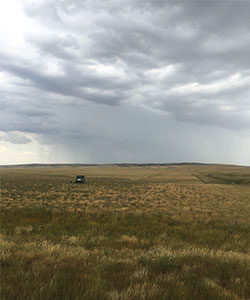
In Hill city, going to Igloo, SD to see where my grandfather grew up. On a homestead in an arid and remote, now deserted part of SD. When he was young, he and his mother would buy groceries and carry them the ten miles from town to the homestead. The economy had collapsed. There were no jobs. For the most part, they lived off the land. They couldn’t afford a horse yet, and my grandfather’s shoes would wear out through the cardboard sole he had cut out to reinforce the sole. I compare that to the progress and innovation that I experience. I can’t help but think about progress--- I mean, now Amazon can deliver using drones!
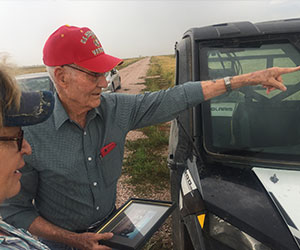
Today, I worked on the first study to get a sense of the color and the composition. I think I want to keep the spectrum around maroons and golds, to play with the University of Minnesota colors. Another setting I’d like to include is the lights looking out over the Mississippi river, which is one of my favorite views of West Bank. And I think I’d like the painting to be a little bit abstract—in part because this is going to be huge.
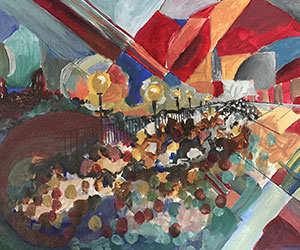
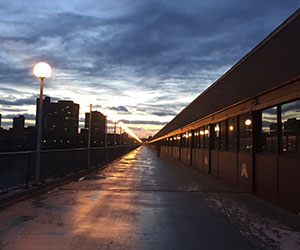
A large box arrived on my doorstep today, which I brought inside. When I took it out of the box though and unfold it, I realize it fits my entire apartment!!! We’ll need somewhere else to work on this thing!
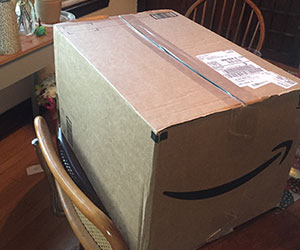
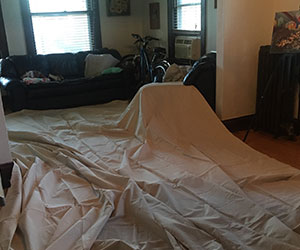
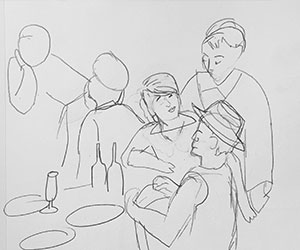
Many paintings have "figures" and "ground." I want there to be figures who embody some of the concepts I’ve been exploring, but also, I want the setting to be local, where Carlson is, as well as highlight the importance of a global perspective. My classmate Priyanka and I were recently discussing how important it is in business school to hear not only from diverse nationalities, but also different backgrounds and industries. Business solutions must be interdisciplinary. I include some initial characters which could express different transactions around the world.
(I am house sitting for my cousin, Sarah this week, and her cat, Simon, helped while I sketch figures in various poses and roles and place them on a canvas.)
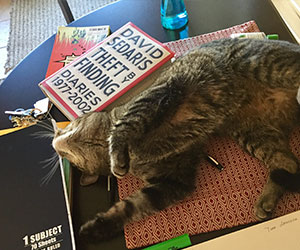
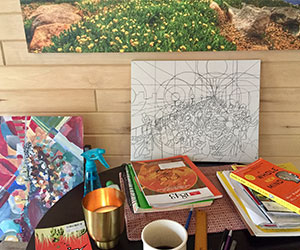
Once this version is finished, I can solicit feedback from others—from classmates, family, the communications office and friends. It’s important to find people who will give a real opinion about what they think can be improved.
Showing the first draft is always a little scary!
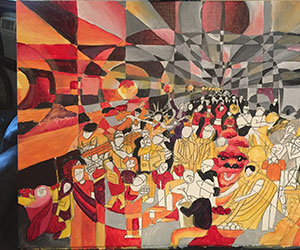
My friend Alex attended art school in San Francisco, and currently is working as a designer in Los Angeles, and his critique is enormously helpful.
Your sky and lights are doing nothing to advance your concept - Make better use of that space. Play with scale of your figures and shapes! Put new story elements up there! Don't be a slave to perspective - experiment with ways to tell your story with better / fuller composition.
You said you want to challenge the idea of business / evolving that with more humanism -- trading of values. So show it!
Remember that humanity is not just bodies - it is also symbols and icons and cultural ideas. The art conversation since the 70s has been about commerce, media & human identity. Be part of that conversation!
You're beginning to separate the browns/grays at the top form the blues in the middle and the warm reds at the bottom... now it's time to commit! Choose your colors, maybe even write out a description of your color theory for your own reference. and stick to it!
Alex encouraged me to look at the work of three artists for some creative inspiration.
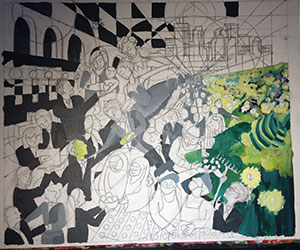
This time, when I start drawing again, I broke out the painting into thirds, which is usually an aesthetic guideline. There are three "pillars" to sustainability. Social; Environmental; and Economic Impact. That might be an interesting way to break up the painting. What I admired looking at the work of Jacob Lawrence are the interlinking of the figures, the connectivity, which the original design lacked. After several hours, the work started to emerge. The figures began to connect. As I drew, I glanced through my notes, remembering my conversations, and think about articulating the ideas of the piece.
Some aspects to improve:
Through this painting, I want to show that although sometimes people think of business as "static people in suits," I want to show how business is dynamic. I wanted to use strong, bold colors and motion to show business is not black and white—business at its best is connected and challenges systems which exist and exploring how things can be done better.
When I finish this version, it feels more alive and vibrant!

I purchased the paints I needed today—I decided to start with three 32oz prime colors, and I figure I can always buy more as needed. I have many of the brushes I need, but I bought a few bigger ones, to make up for the space of it. Art Materials on Lyndale is within walking distance from my house, which is extremely convenient.
I showed the new painting to the communications department. For dramatic effect, I showed the first version, reviewed what we discussed and then unveiled the new design. The school liked it. I’m excited to get started on the real, large version!
We were able to get approval to use the theater on the third floor of the People’s Center Clinic for the painting. Soon the space will be remodeled for office space, but for the next month, it will be my studio! We have the space (At the People’s Center Clinic) starting on Tuesday.
First day of school, and also first day really getting started on the main canvas. When I unfold the canvas in here, it fills the entire stage. Moe shows us how to control the stage lights, and it’s time to get to work! The canvas is raw--- and needs to be primed before I can paint acrylics onto it. For the base, I purchased house paint primer. On smaller canvasses, the common primer is gesso, but housing primer does the trick, too. I used a rolling tray and roller to apply the first coat. I started with one edge, and moved backward, pulling the primer toward myself. I got half way on the first coat. Not bad for one day! Then I slipped back into regular clothes and hurried across the street to class for corporate strategy!
It took two coats to seal the canvas—it’s "thirsty" (meaning it’s soaked in all the primer), which is a good thing. I don’t want it to absorb the more expensive acrylic paint. I end up giving it two coats.
For a painting this large, measuring is crucial. I’ll need to set up a grid to recreate the sketch on this larger canvas. A grid is a common tool used for transferring large images, and because of the sheer scale of the painting, this will help me considerably. My smaller draft is 15 x 18 inches, and the painting is 15 x 18 ft! I used plastic wrap to cover the smaller painting, and drew the gird directly onto the face of the plastic, so I can see the images. Then, I drew the same grid, but on a massive scale, onto the large canvas. It’s important to be meticulous when measuring. One miscalculation here could cause me real headaches down the road. This process takes a few days.
Once the grid was drawn, I began to fill in the squares with the shapes and lines on the smaller canvas. I try not to think of the forms as figures because otherwise my brain plays tricks on me.
"No way his head’s that big." I thought, "Oh but it is," I had to tell myself, "It is that big!" Sometimes, if my brain is really confusing me about the dimensions, I sketch the shapes upside down in an attempt to turn off what my left brain tells me is true. This is a useful way to let your right brain drive the action.
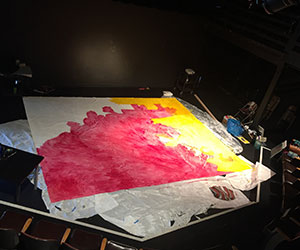
Today I the first day of adding color to the canvas. The painting process to me is like a pyramid. I start with the base and then build the forms on top of it, block by block until it’s the top, which are the details. That part is often the most fun. I like to start from solid based colors—the dominant colors of a section. The painting is essentially maroon and gold base, so those go on first. Acrylic when mixed with water is transparent enough to see the pencil lines, so I know where I’m going. The colors are bold and striking, especially from the second level of the theater. It’s fun to watch this come to life again—but so big!
My arms are sore today—painting murals might be a great workout regimen.
Most of the mid-tones have been added to the figures. I have been painting color by color—one day, a deep maroon. I walked over the painting, careful for the wet areas, and moved from area to area, deciding which spots needed that color. The painting is safe to walk on. Acrylic dries quickly, which makes it a forgiving medium with which to work. Scurrying over this large canvas, I feel like a mouse on such a large space. I step carefully though to avoid wet spots. (But there might be a few footprints left behind.) Bit by bit, and block by block the figures emerged. The suits became deep indigos and violets. As the figures came to life, wearing their professional garments, I try to design outfits which would be commendable by the Graduate Business Career Center, the folks who advise us before interviews and networking receptions. I add ties and accessories to each individual. The skin and hair tones of the figures range from oranges to pinks, and reds and violets representing the range of people and backgrounds found at Carlson and in our greater community.
I’m getting to the part of the painting process where sometimes I correct and recorrect what I’ve already done. I do this when I first arrive, because having fresh eyes helps me see what connects and what doesn’t. You want the figures to "stand alone" but also feel connected to the larger piece.
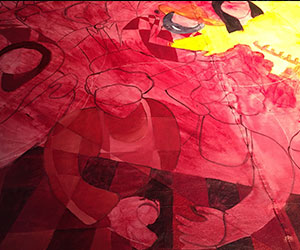
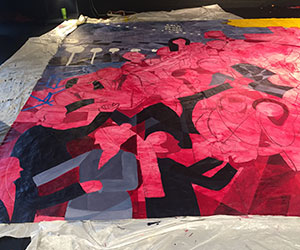

I’m getting pretty close to the end! I can see where darks need to be darker and where lights need to be lighter. I applied second layers of painting to any areas which should be bolder. To the city, I added lights in the windows, and a glowing rim around the Gold Medal Flour sign-- overlooking the Stone Arch Bridge. To the physician, I gave a stethoscope, a device to help her check the heartbeat of her young patient, and to the farmer, I gave a rake, which he can use to work the soil, growing food for our community. The environmental side challenges me because I want the colors to tie back to the other side, the golden tones are important. I had it as rows of corn and fields, but I thought it might be too much green. I wanted it to tie in with the rest of the painting, so maybe I need more gold…
I decided to add in more gold by adding flowers. I like that the colors help to tie and balance the colors and shapes on the opposite end of the painting. Also, the sunflowers stand out now, and weigh out the lights from the bridge on the upper left corner.
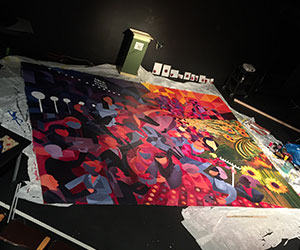
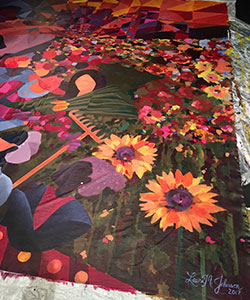
I started the painting exactly a month ago. It’s come a long way since then! I get to step away and see the painting as a whole. When I used to teach painting classes, I would tell my students, the two hardest strokes are the first and the last. Getting started can feel overwhelming—staring at a black canvas. But perhaps harder still is knowing when you’re done and when it’s finished. Stepping away from the painting, I looked at the figures, the places in the community, and the values this work represents. A successful painting should draw the eye and achieve a harmony and balance. Today, I put the final mark, my signature, on the painting!
There’s a quote I like from Fyodor Dostoevsky which says, "At first, art imitates life. Then life will imitate art. Then life will find its very existence from the arts." It is business leaders who will create the innovative solutions necessary to solve the problems of tomorrow. To do so, we need knowledge, skills, diverse perspectives and creativity. These are the factors which make business a force for good.

Carlson School of Management
321 19th Avenue South